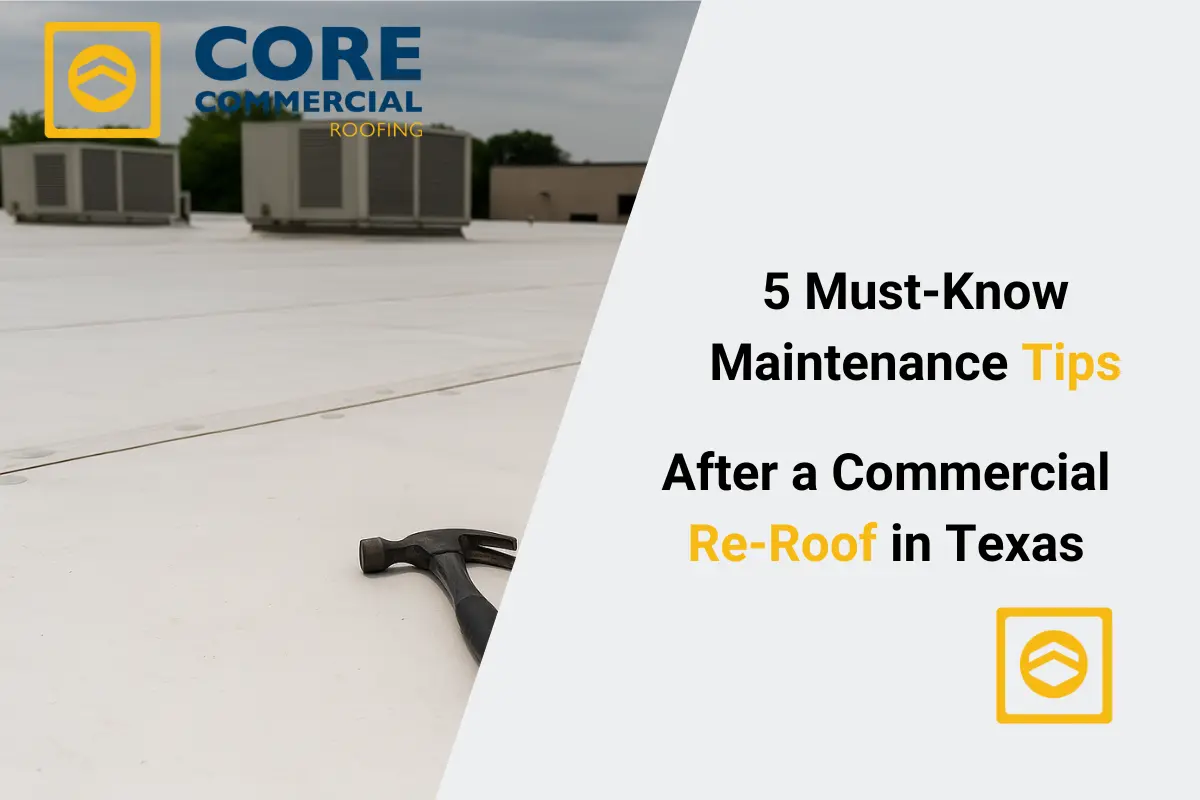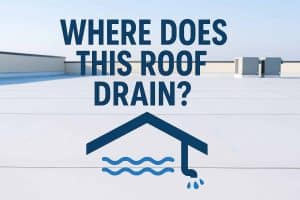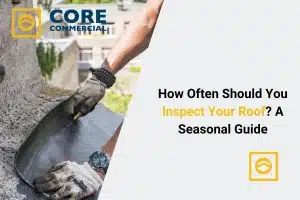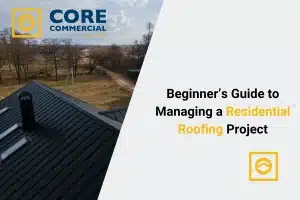After investing in a commercial re-roofing project in Texas, many building owners and facility managers assume the hard part is over. But the truth is, your roof’s lifespan and performance now depend on what you do after the installation. With Texas’s intense heat, heavy rainstorms, and unpredictable wind events, post-installation maintenance isn’t just helpful — it’s essential. In this article, you’ll discover five crucial maintenance tips that help you protect your investment, prevent costly repairs, and ensure your roof performs at its best for decades to come.

Whether you manage an office building in Houston, a warehouse in Dallas, or a shopping center in San Antonio. These actionable tips are tailored to Texas’s unique climate and core roofing systems challenges. Let’s explore how regular care can save you money, reduce downtime, and keep your commercial property protected year-round.
1. Schedule Bi-Annual Roof Inspections (And Stick to Them)
In Texas, skipping routine roof inspections is like skipping oil changes for your car — eventually, it’ll cost you.
Why Twice a Year?
Texas experiences extreme weather swings — from scorching sun to flash floods. Inspecting your roof twice a year (ideally in the spring and fall) helps identify small issues before they become expensive emergencies. These inspections should also follow major weather events like hailstorms or hurricanes.
What to Look For
- Cracks, punctures, or blisters in the membrane
- Loose flashing around vents, HVAC units, and skylights
- Clogged drains or scuppers can lead to ponding water
- Signs of animal activity, like nesting or droppings
- Seam separations or wrinkles in the roofing material
Pro Tip:
Use a certified commercial roofing contractor familiar with Texas codes and materials. Document each inspection with photos and written reports to build a history and catch patterns early.
2. Clean Gutters, Drains, and Scuppers Regularly
Texas roofs don’t just handle rain — they deal with dust storms, oak pollen, leaves, bird nests, and even the occasional tumbleweed. All of this debris can clog your drainage system, leading to standing water, a top reason for premature roof failure. Here we are, Core roofing, always ready to help you!
Why Drainage Matters
Flat or low-slope roofs on commercial buildings depend heavily on working drainage. When water can’t escape, it pools. That water adds weight, encourages leaks, promotes mold, and even voids warranties.
What to Do
- Clean gutters and downspouts at least four times a year
- Ensure all scuppers and internal drains are free of blockage
- Look for slow-draining areas after storms — a sign of hidden debris
Tip for Texas Businesses:
If your building is near trees (especially live oaks), consider mesh guards or leaf screens to prevent clogging without reducing water flow.
3. Stay on Top of Roof Debris and Foot Traffic Damage
Unlike homes, commercial roofs often support maintenance teams working on HVAC units, antennas, or solar panels. This foot traffic increases wear and tear, especially if crews aren’t using walk pads or designated paths.
How Damage Happens
Even a single technician dropping a tool or stepping in the wrong spot can puncture membranes, loosen seals, or displace insulation. Over time, these small injuries add up to big repair bills.
How to Prevent It
- Install marked walk paths
- Use protective mats or pavers near service areas
- Post signs reminding staff to stay within paths
- Train vendors and maintenance staff on roof safety protocols
Fast Fix:
Conduct a quick inspection anytime a crew accesses the roof, even if the job has nothing to do with roofing.
4. Monitor for Signs of Moisture and Interior Leaks
Many roof issues show up inside before they’re visible outside. If you’re only watching the roof, you might miss early warning signs until it’s too late.
What to Watch For Inside
- Brown water stains on ceilings or walls
- Peeling paint or bubbling drywall
- Musty odors indicate hidden mold
- Higher HVAC costs (which can signal insulation damage from leaks)
The Importance of Early Action
Ignoring these signs lets water infiltrate insulation, damage interior finishes, and create an environment for mold, all of which escalate repair costs quickly. The longer you wait, the deeper the water travels.
Preventative Action
- Add roof monitoring to your regular building walkthroughs
- Log and date any ceiling issues for comparison later
- Match interior moisture signs with recent weather events
5. Keep a Roof Maintenance Log and Document Everything
Good documentation is your best defense when a warranty claim, insurance dispute, or tenant issue arises. Texas weather can be brutal, but without proof of proper maintenance, you could be left footing the repair bill alone.
What to Record
- Dates and results of inspections
- Photos from each maintenance visit
- Copies of repair invoices and service provider info
- Notes on storms or events that may have impacted the roof
- Any communication with roofers, vendors, or insurance agents
Why It Matters
Manufacturers and insurers often require proof of maintenance to honor warranties or claims. Without this record, even a valid issue might be denied simply because of a lack of documentation.
Smart Tip:
Use a cloud-based tool or spreadsheet so your records are accessible, secure, and easily shareable.
Bonus Tip: Know When to Call the Pros
Texas commercial roofs face unique stress from sun exposure, rapid temperature fluctuations, and extreme weather conditions. Even if you follow all the tips above, professional help is sometimes necessary, and waiting too long can turn a simple fix into a full roof replacement.
If you notice persistent leaks, unusually high energy bills, or roof materials breaking down faster than expected, it’s time to call a certified commercial roofer in Texas. Choose a contractor with local experience and a reputation for honest evaluations, not just selling replacements.
Final Thoughts: Make Roof Maintenance a Business Priority
A new roof isn’t the end of your roofing responsibilities — it’s the beginning of a maintenance journey that will either extend or shorten your roof’s lifespan. In Texas, with its harsh weather conditions, proactive maintenance isn’t optional. It’s a strategic investment that protects your building, your budget, and your peace of mind.
By sticking to regular inspections, keeping drainage clear, controlling foot traffic, watching for leaks, and documenting everything, you set yourself up for long-term success. These practices can add years to your roof’s life, minimize disruption to your operations, and prevent the kinds of costly surprises that no business wants.
Remember, your roof is a business asset. Treat it like one — and it will reward you with years of solid, leak-free performance.
FAQs
How many times should I check my commercial roof in Texas?
You should inspect your commercial roof at least twice a year—once in the spring and once in the fall. Additionally, it’s important to check your roof after major weather events like hailstorms or hurricanes to catch any damage early and prevent costly repairs.
What are the signs of roof damage after a Texas storm?
After a storm, look for water stains on ceilings, missing or damaged roofing materials, clogged drains, and any sagging areas on the roof. These signs can indicate leaks or structural issues that need immediate attention to prevent further damage.
Why is it important to take care of your roof regularly in Texas?
Regular maintenance helps extend the life of your roof, prevents leaks, and saves money by addressing small issues before they become big problems. Texas weather can be tough on roofs, so consistent care is key to protecting your investment.
How do I prevent water pooling on my flat commercial roof?
To prevent water pooling, ensure that gutters and drains are clear of debris like leaves and dirt. Regularly check for and remove any blockages, and consider installing additional drainage solutions if pooling persists after heavy rains.
Can I perform roof inspections myself?
While you can do basic visual checks, it’s recommended to hire a professional roofing contractor for thorough inspections. They have the expertise to identify hidden issues and ensure your roof remains in good condition, especially after severe weather.
What should I include in a roof maintenance log?
Your maintenance log should record inspection dates, findings, photos of any damage, repairs made, and the names of contractors who performed the work. Keeping detailed records helps with warranty claims and future maintenance planning.
How does Texas heat affect my commercial roof?
Texas heat can cause roofing materials to expand and contract, leading to cracks and deterioration over time. UV rays can also degrade the roof’s surface. Regular inspections and maintenance help mitigate these effects and prolong your roof’s lifespan.
What are the common causes of commercial roof leaks in Texas?
Common causes include clogged drains, damaged flashing, punctures from debris, and wear and tear from extreme weather conditions. Regular maintenance helps identify and fix these issues before they lead to significant leaks.
Is it good to put a coating on a commercial roof in Texas?
Yes, applying a reflective roof coating can protect against UV damage, reduce heat absorption, and extend the roof’s life. It’s especially beneficial for flat or low-slope roofs common in commercial buildings across Texas.
When should I call a professional for roof maintenance?
You should call a professional if you notice signs of damage, after severe weather events, or if it’s been over six months since your last inspection. Professionals can provide a comprehensive assessment and perform necessary repairs to keep your roof in top shape.






